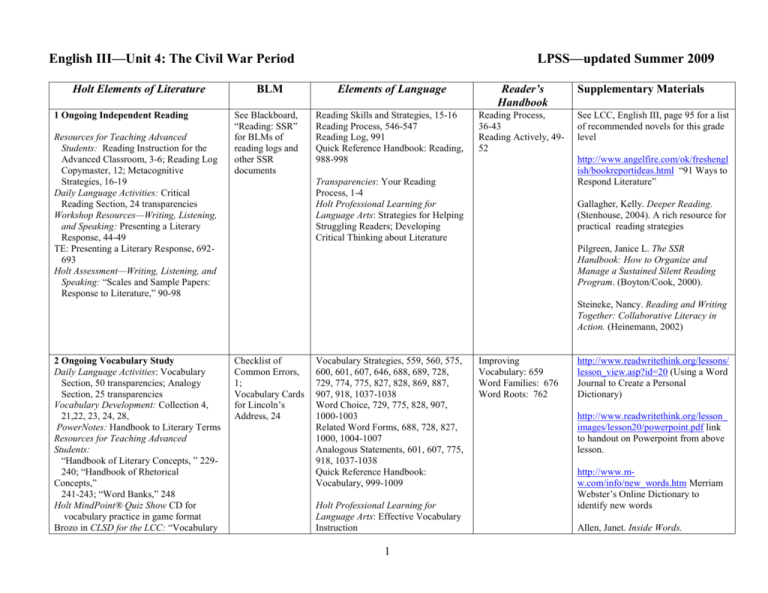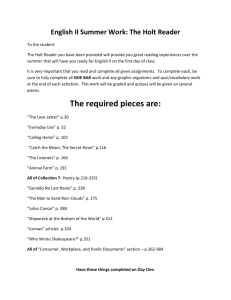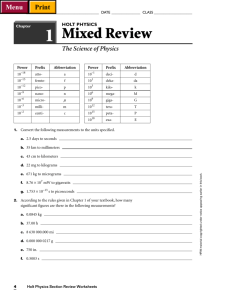Unit 4 Civil War
advertisement

English III—Unit 4: The Civil War Period Holt Elements of Literature 1 Ongoing Independent Reading Resources for Teaching Advanced Students: Reading Instruction for the Advanced Classroom, 3-6; Reading Log Copymaster, 12; Metacognitive Strategies, 16-19 Daily Language Activities: Critical Reading Section, 24 transparencies Workshop Resources—Writing, Listening, and Speaking: Presenting a Literary Response, 44-49 TE: Presenting a Literary Response, 692693 Holt Assessment—Writing, Listening, and Speaking: “Scales and Sample Papers: Response to Literature,” 90-98 BLM See Blackboard, “Reading: SSR” for BLMs of reading logs and other SSR documents LPSS—updated Summer 2009 Elements of Language Reader’s Handbook Reading Skills and Strategies, 15-16 Reading Process, 546-547 Reading Log, 991 Quick Reference Handbook: Reading, 988-998 Reading Process, 36-43 Reading Actively, 4952 Supplementary Materials See LCC, English III, page 95 for a list of recommended novels for this grade level http://www.angelfire.com/ok/freshengl ish/bookreportideas.html “91 Ways to Respond Literature” Transparencies: Your Reading Process, 1-4 Holt Professional Learning for Language Arts: Strategies for Helping Struggling Readers; Developing Critical Thinking about Literature Gallagher, Kelly. Deeper Reading. (Stenhouse, 2004). A rich resource for practical reading strategies Pilgreen, Janice L. The SSR Handbook: How to Organize and Manage a Sustained Silent Reading Program. (Boyton/Cook, 2000). Steineke, Nancy. Reading and Writing Together: Collaborative Literacy in Action. (Heinemann, 2002) 2 Ongoing Vocabulary Study Daily Language Activities: Vocabulary Section, 50 transparencies; Analogy Section, 25 transparencies Vocabulary Development: Collection 4, 21,22, 23, 24, 28, PowerNotes: Handbook to Literary Terms Resources for Teaching Advanced Students: “Handbook of Literary Concepts, ” 229240; “Handbook of Rhetorical Concepts,” 241-243; “Word Banks,” 248 Holt MindPoint® Quiz Show CD for vocabulary practice in game format Brozo in CLSD for the LCC: “Vocabulary Checklist of Common Errors, 1; Vocabulary Cards for Lincoln’s Address, 24 Vocabulary Strategies, 559, 560, 575, 600, 601, 607, 646, 688, 689, 728, 729, 774, 775, 827, 828, 869, 887, 907, 918, 1037-1038 Word Choice, 729, 775, 828, 907, 1000-1003 Related Word Forms, 688, 728, 827, 1000, 1004-1007 Analogous Statements, 601, 607, 775, 918, 1037-1038 Quick Reference Handbook: Vocabulary, 999-1009 Holt Professional Learning for Language Arts: Effective Vocabulary Instruction 1 Improving Vocabulary: 659 Word Families: 676 Word Roots: 762 http://www.readwritethink.org/lessons/ lesson_view.asp?id=20 (Using a Word Journal to Create a Personal Dictionary) http://www.readwritethink.org/lesson_ images/lesson20/powerpoint.pdf link to handout on Powerpoint from above lesson. http://www.mw.com/info/new_words.htm Merriam Webster’s Online Dictionary to identify new words Allen, Janet. Inside Words. English III—Unit 4: The Civil War Period Holt Elements of Literature BLM Cards,” 26; “Vocabulary SelfAwareness,” 27; “Word Grid,” 28 LPSS—updated Summer 2009 Elements of Language Reader’s Handbook Six Traits: Word Choice, 11-13, 104105 Word Sharp: Context Clues: Synonym, Antonym, Contrast, Comparison, Example, Restatement; Word Structure: Prefixes, Latin Roots, Greek and Anglo-Saxon Roots, Suffixes Vocabulary Workshop: Making New Words Your Own (word attack strategies),1ff.; Connecting New Words and Patterns (analogies), 123ff.; Reading New Words in Context (context clues), 141ff.; Vocabulary Words, 233-234 Writing Strategies & Applications, Writer’s notebook, 1076 Informal Writing to Learn: Reading Log, 991; Graphic Organizers, 10681069; Outlines, 1071; Prewriting Techniques, 1073-1076. 3 Ongoing Writing Prompts Powernotes: Collection 3, Quickwrites, slide 1; Collection 4, slides 1-2 Brozo in CLSD for the LCC: QtA (Questioning the Author), 12 Holt Assessment—Writing, Listening, and Speaking: Portfolio Assessment, 121-161 (Stenhouse, 2007). Practical strategies for teaching vocabulary that work up and down the curriculum Connect to Reading: 41 http://www.readwritethink.org/lessons/ lesson_view.asp?id=902 “Draft letters,” for students to think critically about major writing assignments. Students write letters of reflection to share with a peer before completing the final draft. http://chiron.valdosta.edu/whuitt/brilst ar/plans/giggey_rubricjournal.pdf class journal rubric www.ksde.org/LinkClick.aspx?filetick et=uoPeZcLNN30%3D&tabid=2089& mid=4762 another journal rubric Reading for Tests, 596-637 http://www.readwritethink.org/lessons/ lesson_view.asp?id=1091 “Analyzing Grammar Pet Peeves” http://owl.english.purdue.edu/owl/reso urce/677/01/ Purdue OWL (Online Writing Lab) http://content1.docstoc.com/flash/Usin Teaching Strategies for English Language Learners: Think as a Writer, 2; prompts in Ch. 21-29 Writing Notes DVD Think as a Writer: Interactive Writing Worktext, prompts in Ch. 21-29 4 Ongoing Grammar Study Daily Language Activities: Proofreading Warmups Section, 27 transparencies; Sentence Combining Section, 15 transparencies Resources for Teaching Advanced Students: Checklist of Common Errors, 1 Grammar, 47-139; Usage, 140-313; Mechanics, 314-477 Commas, 338-363 Diction, 575, 618-619, 842-843, 930933 Quotation Marks, 379-387 Parallel Structure, 486-487, 1099 2 Supplementary Materials English III—Unit 4: The Civil War Period Holt Elements of Literature “Handbook of Grammatical Concepts, ” 244-247 Powernotes: Proofreading warm-ups, 12 slides Holt Virtual File Cabinet: grammar pages for Practice, Remediation, Assessment, Review, and Enrichment TE: Taking the SAT and the ACT, LA19LA32; Test Smarts, 1395 5 The Autobiography of Frederick Douglass TE: 462-470; “from My Bondage and My Freedom,” 478; Meet the Writer: Frederick Douglass, 463; “from Narrative of the Life of Frederick Douglass,” 465 Holt Reading Solutions: Alternative Lesson Plans, 127; Adapted Reading, 365; Vocabulary and Comprehension (copying master), 131 BLM LPSS—updated Summer 2009 Elements of Language Reader’s Handbook Passive/Active Voice, 240-244 Sentence Clarity, 480-497 Sentence Combining, 498-508, 706708 Style, 510-514, 574-575, 661-663, 618-619, 807-809, 842-843, 886-887, 931-933 g%20Quotations.swf Flash-based overview of quotations http://www.readwritethink.org/lessons/ lesson_view.asp?id=248 “Manipulating Sentences to Reinforce Grammar” http://www.docstyles.com/mlaquick.ht m quick reference to MLA style http://www.collegeboard.org Students can sign up to have a daily SAT question delivered to their emailboxes. Other invaluable resources for college are available here. http://grammar.ccc.commnet.edu/gram mar/ student guide to grammar and writing http://www.testprepreview.com/ free practice tests for ACT, SAT, MCAT, LSAT, etc. http://www.actstudent.org/sampletest/i ndex.html for ACT preparation Grammar Notes DVD, Lesson 11 (passive/active voice), Lesson 30 (strong verbs) Holt Professional Learning for Language Arts: Teaching Grammar in Context Transparencies: Proofreading Warmups, Sentence Combining Six Traits: Sentence Fluency, 14, 106112; Conventions, 17,113-118 Thinking as a Writer: Interactive Grammar Worktext: Sections 1, 2, 3 Grammar, Usage, Mechanics: Language Skills Practice, Ch. 1-14, 16 Developmental Language Skills: Ch. 1-14, 16 Preparing for the SAT and ACT Holt Professional Learning for Language Arts: Teaching Narrative and Expository Texts 3 Supplementary Materials Biographies, 702 Organization of, 204205 Reading strategies, 199 Outlining, 208 Autobiographies, 210 Memoirs-synthesizing, 214-215 Note-taking, 718-719 http://docsouth.unc.edu/neh/douglass/d ouglass.html an e-text of Narrative of the Life of Frederick Douglass http://docsouth.unc.edu/neh/douglass5 5/menu.html e-text of My Bondage and My Freedom English III—Unit 4: The Civil War Period Holt Elements of Literature BLM LPSS—updated Summer 2009 Elements of Language Reader’s Handbook Supplementary Materials Resources for Teaching Advanced Students, Alternative Lesson Plans, 126 PowerNotes: Collection 4, “Narrative of the Life” The Holt Reader: “from Narrative of the Life of Frederick Douglass,” 162 Holt Adapted Reader: Adapted Reading (with apparatus), 112; Graphic Organizer—Metaphor, 117 Audio CD Library, disc 9 Vocabulary Development: 21 Holt Assessment: Literature, Reading, and Vocabulary, “from Narrative of the Life of Frederick Douglass,” 155 Fine Art Transparencies: Transparency 8; Teaching Notes, Worksheets, and Answer Key, 23 6 Comparing/Contrasting Autobiographies TE: “from Incidents in the Life of a Slave Girl,” 472; Meet the Writer: Harriet A. Jacobs, 471; Introducing Political Points of View: Slavery, 462; “from Incidents in the Life of a Slave Girl,” 473 Holt Reading Solutions: Making Inferences, 248; Summarizing, 254; Comparing and Contrasting, 290 Resources for Teaching Advanced Students: Word Banks—Tone, 270; Style, 271; Mood, 271 Audio CD Library, disc 9 Vocabulary Development, 22 Holt Assessment: Literature, Reading, and FranklinDouglass Graphic Organizer, 21; Composition Rubric for Comparing Autobiographies, 22 Autobiographical Narrative, 549-585 Descriptive details, 550, 557 Structure of a composition, 527-540 Compositions, 1061-1064 Writing Notes DVD, NarrationDescription, Lesson 14 Think as a Writer: Interactive Writing WorkText, Ch. 21 Teaching Strategies for English Language Learners, Ch. 21 Transparencies, 10-12; Daily Writing Transparencies 8-14 (voice) Holt Professional Learning for Language Arts: Teaching Students to Revise, Not Recopy 4 Focus on Comparing and Contrasting, 359365 http://docsouth.unc.edu/fpn/jacobs/jac obs.html e-text of Incidents in the Life of a Slave Girl, another slave narrative for comparison to Douglass and Franklin, if desired English III—Unit 4: The Civil War Period Holt Elements of Literature BLM Vocabulary, “from Incidents in the Life of a Slave Girl,” 158 7 The Language of Spirituals TE: spirituals, 480-482 Holt Assessment: Literature, Reading, and Vocabulary, “from My Bondage and My Freedom”; “Go Down, Moses”; “Follow the Drinking Gourd”; “Swing Low, Sweet Chariot”; “The Most Remarkable Woman Of This Age,” 161 Audio CD Library Disc 9, selections 5, 6, 7 LPSS—updated Summer 2009 Elements of Language Reader’s Handbook Supplementary Materials Six Traits for Writing, 8-10 Analyzing the Refrain in a Spiritual, 23 http://edsitement.neh.gov/view_lesson _plan.asp?id=318 “Spirituals” http://docsouth.unc.edu/ Documenting the American South Summary notes, 719, 754 Summarizing for news stories, 190-191 Author’s Purpose, 251, 725 Reading a News story, 181 8 Life during the Civil War Period through Photos, Journals, and Letters TE: “Letter to His Son,” 511; “Letter to Sarah Ballou,” 513; “from A Diary from Dixie,” 515; Reteaching Lessons- Irony, Tone, and Author’s Style, 1329L-M Holt Reading Solutions: Making Inferences, 248; Summarizing, 254 9 The Women’s Movement and Sojourner Truth 5 http://memory.loc.gov/learn/lessons/98 /brady/home.html Photographs by Matthew Brady http://memory.loc.gov/ammem/cwpht ml/cwphome.html Civil War photographs http://docsouth.unc.edu/ Documenting the American South http://www.teacheroz.com/Civil_War_ Documents.htm primary documents from the Civil War http://www.archives.gov/education/ind ex.html National Archives lesson plans, with links to primary documents—photos, letters, etc. http://www.onlinenewspapers.com/ index of newspapers online http://www.thebigproject.co.uk/news/ newspapers in English from all over the world http://www.sojournertruth.org/History/ Biography/Default.htm Photographs http://www.wfu.edu/~zulick/340/sojou rner.html text of “Arn’t I a Woman?” English III—Unit 4: The Civil War Period Holt Elements of Literature 10 Fiction of the Civil War TE: “Occurrence at Owl Creek Bridge,” 489-497; “A Mystery of Heroism,” 498507; Meet the Writer: Stephen Crane, 499; Introducing Political Points of View: The Civil War, 498; “War Is Kind,” 509;Meet the Writer: Ambrose Bierce, 488; Reteaching Theme and Meaning, 1361M-N; Reteaching Patterns of Organization, 1361D The Holt Reader: “A Mystery of Heroism,” 173 Holt Adapted Reader: Adapted Reading (with apparatus), 118 (“A Mystery of Heroism”); Graphic Organizer: Situational Irony, 123; Adapted Reading (with apparatus), 130; Graphic Organizer: Cause and Effect, 137 Resources for Teaching Advanced Students: Word Banks—Tone, 270; Style, 271; Mood, 271; Character, 272 BLM LPSS—updated Summer 2009 Elements of Language Quotations: citing sources of, 735; incorporating, 745-747, 799; notetaking and, 786 Holt Professional Learning for Language Arts: Strategies for Helping Struggling Readers; Using Literature Circles Holt Reading Solutions: Understanding Characters, 266-271 Recognizing Theme, 272-277 Understanding Figurative Language, 278-283; Alternative Lesson Plans; 132; Adapted Reading: “A Mystery of Heroism,” 368; Vocabulary and Comprehension (copying master), 136 Additional Vocabulary Practice (copying master), 137; Adapted Reading, 372 Audio CD Library, disc 10, 12 Vocabulary Development: 23 (“Occurrence”); 24 (“A Mystery of Heroism”) Holt Assessment: Literature, Reading, and 6 Reader’s Handbook Supplementary Materials Reading a Short Story, 237 Elements of Fiction, 366 Focus on: Plot, 313-322; Setting, 323- 331; Characters, 332-344; Theme, 345-350; Dialogue, 351-358; C/C, 359 Killer Angels is available from Random House/Ballantine Books. ISBN: 0345348109 English III—Unit 4: The Civil War Period Holt Elements of Literature BLM LPSS—updated Summer 2009 Elements of Language Reader’s Handbook Supplementary Materials Vocabulary, “A Mystery of Heroism”; “War Is Kind,” 167; “An Occurrence at Owl Creek Bridge,” 164 Fine Art Transparencies: Transparency 9 (for “A Mystery of Heroism”); Teaching Notes, Worksheets, and Answer Key (for “A Mystery of Heroism”), 26; Transparency 10, Teaching Notes, Worksheets, and Answer Key, 29 PowerNotes: Collection 4, “Bridge”; Heroism” Brozo in CLSD for the LCC: SPAWN 11 Lincoln’s Gettysburg Address TE: 514 Vocabulary Cards for Lincoln’s Address, 24 Holt Professional Learning for Language Arts: Teaching Narrative and Expository Texts Focus on Speeches, 239 Evaluating the Speech, 244 12 The Poetry of Walt Whitman TE: Meet the Writer: Walt Whitman, 360 “I Hear America Singing,” 364; from Song of Myself—Numbers 10, 33, 52; “A Sight in Camp in the Daybreak Gray and Dim,” 375; Primary Source--“from Speciman Days” (journal), 377; Connection: “from Hospital Sketches,” 379; from Song of Myself—Number 6, 415-416; “When I Heard the Learn’d Astronomer,” 417; “A Noiseless Patient Spider,” 418 Holt Reading Solutions: Alternative Lesson Plans, “I Hear America Singing” 105; Vocabulary and Comprehension (copying master) 107; Alternative Lesson Plans, 108; “from Song of Myself, Number 10,” 368; “from Song of Myself, Number 33,” 370; Adapted Reading: “from Song of Myself: 10 Alone far in Analyzing Whitman’s Poetry, 25; Composition Rubric for Whitman, 26 Support for literary analysis, 726-727 Quotations: citing sources of, 735; incorporating, 745-747, 799; notetaking and, 786 Evaluating Web Sites, 813-816 Reading Poetry, 387 Poetry: Focus on: Language, 400; Meaning, 408; Sound and Structure, 415; Elements of Poetry, 423 Writing and Researching in a Digital Age DVD, 15 lessons Think as a Writer: Interactive Writing WorkText, Ch. 26 Transparencies, 25-27 WritingNotes DVD, Lesson 18 Teaching Strategies for English Language Learners, Ch. 26 7 http://www.readwritethink.org/lesson_ images/lesson885/gettysburg-webresources.html for background, transcript, and reading of the speech http://streaming.discoveryeducation.co m/home/ aboutus.cfm OR http://www.history.com for video biography http://www.memory.loc.gov/ammen/c ollections/whitmanhome http://www.wsu.edu/~campbelld/amlit/ whitman.htm http://www.waltwhitman.org English III—Unit 4: The Civil War Period Holt Elements of Literature BLM LPSS—updated Summer 2009 Elements of Language the wilds,” 351; “from Song of Myself: 33 I understand the large hearts of heroes,” 353; Vocabulary and Comprehension (copying master), 112; Additional Vocabulary Practice (copying master),113; Adapted Reading, 358 The Holt Reader: “I Hear America Singing,” 128; “from Song of Myself, Number 33,” 131; “from Song of Myself, Number 52,” 136 Holt Adapted Reader: Adapted Reading (with apparatus), 90; Graphic Organizer—Free Verse, 99; Adapted Reading (with apparatus), 90; Graphic Organizer—Free Verse, 99 Holt Assessment: Literature, Reading, and Vocabulary, “A Sight in Camp in the Daybreak Gray and Dim,” “from Specimen Days,” “from Hospital Sketches,” 132; “I Hear America Singing,” 123; “from Song of Myself, Numbers 10 and 33,” 126; “from Song of Myself, Number 52,” 129 Fine Art Transparencies: Transparency 6; Teaching Notes, Worksheets, and Answer Key, 17 Audio CD Library, disc 8 PowerNotes: Collection 3, “I Hear America” (focus on catalogue); “Song of Myself” (focus on comparing themes); Historical Introduction—American Masters Whitman and Dickinson Visual Connections: Segment 5, “American Dreamers, Part 1”; Segment 6 “Poetry: Life in Language” Segment 7, “Favorite Poetry Project: ‘Song of Myself’ 8 Reader’s Handbook Supplementary Materials




